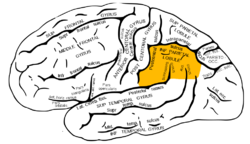Inferior parietal lobule: Difference between revisions
NeuroLex Connectivity |
HiYahhFriend (talk | contribs) No edit summary |
||
| Line 55: | Line 55: | ||
}} |
}} |
||
</ref> and interpretation of sensory information. The Inferior parietal lobule is concerned with language, mathematical operations, and body image, particularly the supramarginal gyrus and the angular gyrus.<ref>{{cite web |url=http://www.neurosurvival.ca/ClinicalAssistant/Examinations/parietal%20lobe/parietal_lobe_testing.html |title= Journal of Neurology, Neurosurgery & Psychiatry| date=2003}}</ref> |
</ref> and interpretation of sensory information. The Inferior parietal lobule is concerned with language, mathematical operations, and body image, particularly the supramarginal gyrus and the angular gyrus.<ref>{{cite web |url=http://www.neurosurvival.ca/ClinicalAssistant/Examinations/parietal%20lobe/parietal_lobe_testing.html |title= Journal of Neurology, Neurosurgery & Psychiatry| date=2003}}</ref> |
||
==Pathologies== |
|||
Damage to the inferior parietal lobule of the dominant hemisphere can result in [[Gerstmann's syndrome]]. |
|||
==Additional images== |
==Additional images== |
||
Revision as of 13:24, 24 February 2014
| Inferior parietal lobule | |
|---|---|
 Lateral surface of left cerebral hemisphere, viewed from the side. (Inferior parietal lobule is shown in orange.) | |
 Lateral surface of left cerebral hemisphere, viewed from above. (Inferior parietal lobule shown in orange.) | |
| Details | |
| Part of | Parietal lobe |
| Identifiers | |
| Latin | lobulus parietalis inferior |
| NeuroNames | 107 |
| NeuroLex ID | birnlex_1194 |
| TA98 | A14.1.09.125 |
| TA2 | 5471 |
| FMA | 77536 |
| Anatomical terms of neuroanatomy | |
The inferior parietal lobule (IPL, subparietal district or lobule) lies below the horizontal portion of the intraparietal sulcus, and behind the lower part of the postcentral sulcus. Also known as Geschwind’s territory after Norman Geschwind, an American neurologist, who in the early 1960s foresaw its importance.[1]
Subdivisions
It is divided from before backward into two gyri:
- One, the supramarginal gyrus, arches over the upturned end of the lateral fissure; it is continuous in front with the postcentral gyrus, and behind with the superior temporal gyrus.
- The second, the angular gyrus, arches over the posterior end of the superior temporal sulcus, behind which it is continuous with the middle temporal gyrus.
Evolution
Functional imaging experiments suggest that the left anterior supramarginal gyrus (aSMG) of the human inferior parietal lobule exhibits an evolved specialization related to tool use. It is not currently known if this functional specialization is unique to humans as complementary experiments have only been performed with macaque monkeys and not apes. The habitual use of tools by chimpanzees makes the uniqueness of the human aSMG an open question as its function may have evolved prior to the split from our last common ancestor.[2]
Function
Inferior parietal lobule has been involved in the perception of emotions in facial stimuli,[3] and interpretation of sensory information. The Inferior parietal lobule is concerned with language, mathematical operations, and body image, particularly the supramarginal gyrus and the angular gyrus.[4]
Pathologies
Damage to the inferior parietal lobule of the dominant hemisphere can result in Gerstmann's syndrome.
Additional images
References
- ^ "The Brain from top to bottom". 2011.
- ^ Peeters et al. 2009
- ^ Radua, Joaquim; Phillips, Mary L.; Russell, Tamara; Lawrence, Natalia; Marshall, Nicolette; Kalidindi, Sridevi; El-Hage, Wissam; McDonald, Colm; Giampietro, Vincent (2010). "Neural response to specific components of fearful faces in healthy and schizophrenic adults". NeuroImage. 49 (1): 939–946. doi:10.1016/j.neuroimage.2009.08.030. PMID 19699306.
- ^ "Journal of Neurology, Neurosurgery & Psychiatry". 2003.
References
- Peeters, R.; Simone, L.; Nelissen, K.; Fabbri-Destro, M. (September 16, 2009). "The Representation of Tool Use in Humans and Monkeys: Common and Uniquely Human Features". The Journal of Neuroscience. 29 (37): 11523–11539. doi:10.1523/JNEUROSCI.2040-09.2009. PMID 19759300.
{{cite journal}}: Invalid|ref=harv(help); Unknown parameter|coauthors=ignored (|author=suggested) (help)
![]() This article incorporates text in the public domain from page 823 of the 20th edition of Gray's Anatomy (1918)
This article incorporates text in the public domain from page 823 of the 20th edition of Gray's Anatomy (1918)





